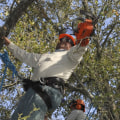The cost of removing a tree can vary greatly depending on its size and condition. The larger the diameter of the tree, the more expensive it will be to remove it, as large logs increase the amount of work required. Costs can also increase by almost 15% if you need to grind the stump. Tree companies charge more to grind shorter but larger stumps than smaller, taller stumps.
The main reason for this is insurance: the tree removal industry is a high-risk business and companies have to pay high premiums just to trade. Workers' compensation insurance is on par with coal miners or iron workers, and companies have to pay close to 25 percent of what an employee earns for this insurance alone. Most companies also have a million-dollar liability policy to cover any property damage that may occur in the event of an accident. When a tree is removed, there are many different levels of service available, but some basic parts are usually included.
The tree will need to be cut down, and usually the contractor will also have to tie up pieces of the tree by climbing the tree and cutting it into more manageable sizes. In many cases, it can also be transported at no additional charge (or is it included in the budget). The good news is that the cost of removing a fallen tree is usually much lower than removing a standing tree. If a short tree has a thick trunk that is particularly laborious to cut, a tree removal company may charge you an extra.
If a tree is longer than 30 feet or is within 10 feet of power lines, it's not at all a DIY project - fines, injuries, or even lawsuits could result if you try to remove a tree in these situations. As far as the above prices are concerned, the total cost of cutting down trees should include cutting the tree into a small stump, chipping and tearing off its branches and cutting its trunk into manageable sections. Dead or dying trees in an urban environment are a hazard and, if one falls, the owner may face a fine for neglecting the tree. To make your yard look as attractive as possible, you periodically need your trees to be cut into shape.
In some places, a permit is needed to remove a tree, while in others it is allowed to professionals who can remove trees without further permits. In addition to making a tree look more aesthetically pleasing, it can be pruned or pruned to remove dead or broken branches that can pose a serious danger. News accounts are full of accident reports involving untrained tree workers, or even homeowners, trying to cut down a tree without knowing how it will respond to the cut. Complexity: Trees that are removed often need to be cut into sections to prevent the entire tree or large pieces from falling onto the grass or landscape or street.
The diameter of a tree trunk can be an easy way to communicate the total size of a tree and get an accurate quote. Whether a tree is tilted, damaged, or just in the wrong place, a tree removal service can cut it down and often dispose of it for you. Tree crews are regularly asked to work on trees with compromised structures due to storm damage or years of neglect. Homeowners have the option of interviewing two or three tree care companies before deciding on tree removal. If you like to have a tree in your garden but want to move it to a different location on your property, consider transplanting it.


